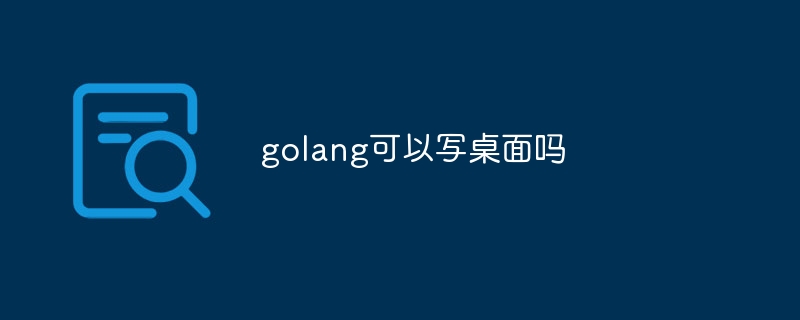
Golang can be used to write desktops. One of the design goals of golang is to provide a simple and efficient development experience, and has the advantages of garbage collection mechanism and concurrent programming. These features make golang an ideal language to develop desktops. applications, especially those that require high performance and concurrent processing. Although golang's standard library does not provide direct support for writing desktop applications, the open source community provides many third-party libraries and frameworks that make it easy and convenient to develop desktop applications using golang.

The operating environment of this article: Windows 10 system, go1.20 version, DELL G3 computer.
Golang is a powerful and flexible programming language, which was developed by Google and has been widely supported and used in the open source community. Although Golang was originally designed as a server-side language for handling concurrent requests and high-performance web applications, it can also be used to write desktop applications.
One of Golang’s design goals is to provide a simple and efficient development experience, with the advantages of garbage collection mechanism and concurrent programming. These features make Golang an ideal language to develop desktop applications, especially for applications that require high performance and concurrent processing.
Although Golang’s standard library does not provide direct support for tools for writing desktop applications, the open source community has provided many third-party libraries and frameworks that make it easy to develop desktop applications using Golang. Simple and convenient.
The following are some Golang libraries and frameworks that can be used to develop desktop applications:
1. Fyne: Fyne is a user specifically designed for Golang Interface toolkit, which provides rich UI components and layout options. Fyne helps developers quickly create beautiful, platform-independent desktop applications.
2. Gotron: Gotron is a cross-platform application framework for using Golang with Electron, making it easy to embed Golang code into Electron applications.
3. Gio: Gio is a library for creating native and cross-platform applications. It provides a simple and powerful API for creating user interfaces and handling multi-threading operate.
4. Walk: Walk is a Windows API binding library that allows developers to write Windows desktop applications using Golang. Walk provides many UI components and controls, as well as functionality for handling Windows events and messages.
5. App: App is a simple framework for building platform-independent desktop applications. It uses the Fyne toolkit and provides additional features such as local and remote data storage, printing, navigation and error handling.
By using these libraries and frameworks, developers can use Golang to create various types of desktop applications, including graphical user interface (GUI) applications, games, and data visualization tools.
In addition to these libraries and frameworks, Golang has many other advantages, making it a very suitable language for developing desktop applications, such as powerful error handling mechanism, cross-platform support, static compilation, etc. . In addition, Golang has excellent performance, it compiles quickly and can easily handle a large number of concurrent requests.
In summary, although Golang was originally designed as a server-side language, it is equally suitable for developing desktop applications. By using third-party libraries and frameworks, developers can easily use Golang to create high-performance, concurrent processing desktop applications. Combining this flexibility with the advantages of Golang, it can be said that Golang is a powerful language that can be used to write various types of applications. Whether it's a server-side or desktop application, Golang is an option worth considering.
The above is the detailed content of Can golang write desktop?. For more information, please follow other related articles on the PHP Chinese website!
 Android desktop software recommendations
Android desktop software recommendations
 How to solve the problem of black screen after turning on the computer and unable to enter the desktop
How to solve the problem of black screen after turning on the computer and unable to enter the desktop
 How to define variables in golang
How to define variables in golang
 What are the data conversion methods in golang?
What are the data conversion methods in golang?
 What are the commonly used libraries in golang?
What are the commonly used libraries in golang?
 What is the difference between golang and python
What is the difference between golang and python
 Usage of parseInt in Java
Usage of parseInt in Java
 prtscr key function
prtscr key function